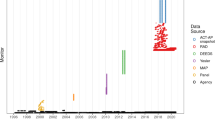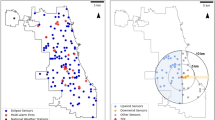Abstract
Background
There is substantial interest in using networks of lower-cost air quality sensors to characterize urban population exposure to fine particulate matter mass (PM2.5). However, sensor uncertainty is a concern with these monitors.
Objectives
(1) Quantify the uncertainty of lower-cost PM2.5 sensors; (2) Use the high spatiotemporal resolution of a lower-cost sensor network to quantify the contribution of different modifiable and non-modifiable factors to urban PM2.5.
Methods
A network of 64 lower-cost monitors was deployed across Pittsburgh, PA, USA. Measurement and sampling uncertainties were quantified by comparison to local reference monitors. Data were sorted by land-use characteristics, time of day, and wind direction.
Results
Careful calibration, temporal averaging, and reference site corrections reduced sensor uncertainty to 1 μg/m3, ~10% of typical long-term average PM2.5 concentrations in Pittsburgh. Episodic and long-term enhancements to urban PM2.5 due to a nearby large metallurgical coke manufacturing facility were 1.6 ± 0.36 μg/m3 and 0.3 ± 0.2 μg/m3, respectively. Daytime land-use regression models identified restaurants as an important local contributor to urban PM2.5. PM2.5 above EPA and WHO daily health standards was observed at several sites across the city.
Significance
With proper management, a large network of lower-cost sensors can identify statistically significant trends and factors in urban exposure.
This is a preview of subscription content, access via your institution
Access options
Subscribe to this journal
Receive 6 print issues and online access
$259.00 per year
only $43.17 per issue
Buy this article
- Purchase on Springer Link
- Instant access to full article PDF
Prices may be subject to local taxes which are calculated during checkout






Similar content being viewed by others
References
Brook RD, Rajagopalan S, Pope CA, Brook JR, Bhatnagar A, Diez-Roux AV, et al. Particulate matter air pollution and cardiovascular disease. Circulation. 2010;121:2331–78.
WHO Europe. Health Aspects of Air Pollution Results from the WHO Project ‘Systematic Review of Health Aspects of Air Pollution in Europe’. 2004 https://apps.who.int/iris/bitstream/handle/10665/107571/E83080.pdf?sequence=1&isAllowed=y.
Pope A, Burnett R, Thun M, Calle E, Krewski D, Ito K, et al. Long-term exposure to fine particulate air pollution. JAMA. 2002;287:1192.
Pope CA, Lefler JS, Ezzati M, Higbee JD, Marshall JD, Kim S-Y, et al. Mortality risk and fine particulate air pollution in a large, representative cohort of U.S. adults. Environ Health Perspect. 2019;127:077007.
Lefler JS, Higbee JD, Burnett RT, Ezzati M, Coleman NC, Mann DD et al. Air pollution and mortality in a large, representative U.S. cohort: multiple-pollutant analyses, and spatial and temporal decompositions. Environ Heal. 2019. 10.1186/s12940-019-0544-9.
Eeftens M, Beelen R, De Hoogh K, Bellander T, Cesaroni G, Cirach M, et al. Development of land use regression models for PM2.5, PM 2.5 absorbance, PM10 and PMcoarse in 20 European study areas; Results of the ESCAPE project. Environ Sci Technol. 2012;46:11195–205.
Malings C, Tanzer R, Hauryliuk A, Saha PK, Robinson AL, Presto AA, et al. Fine particle mass monitoring with low-cost sensors: corrections and long-term performance evaluation. Aerosol Sci Technol. 2019;0:1–15.
De Nazelle A, Seto E, Donaire-Gonzalez D, Mendez M, Matamala J, Nieuwenhuijsen MJ, et al. Improving estimates of air pollution exposure through ubiquitous sensing technologies. Environ Pollut. 2013;176:92–99.
Schneider P, Castell N, Dauge FR, Vogt M, Lahoz WA, Bartonova A. A network of low-cost air quality sensors and its use for mapping urban air quality. In: Earth Systems Data and Models Mobile Information Systems Leveraging Volunteered Geographic Information for Earth Observation. Cham: Springer International Publishing; 2018, p. 93–110.
Popoola OAM, Carruthers D, Lad C, Bright VB, Mead MI, Stettler MEJ, et al. Use of networks of low cost air quality sensors to quantify air quality in urban settings. Atmos Environ. 2018;194:58–70.
Masiol M, Zíková N, Chalupa DC, Rich DQ, Ferro AR, Hopke PK. Hourly land-use regression models based on low-cost PM monitor data. Environ Res. 2018;167:7–14.
Castell N, Dauge FR, Schneider P, Vogt M, Lerner U, Fishbain B et al. Can commercial low-cost sensor platforms contribute to air quality monitoring and exposure estimates? Environ Int. 2017. 10.1016/j.envint.2016.12.007.
Schneider P, Castell N, Vogt M, Dauge FR, Lahoz WA, Bartonova A Mapping urban air quality in near real-time using observations from low-cost sensors and model information. Environ Int. 2017. 10.1016/j.envint.2017.05.005.
Mead MI, Popoola OAM, Stewart GB, Landshoff P, Calleja M, Hayes M, et al. The use of electrochemical sensors for monitoring urban air quality in low-cost, high-density networks. Atmos Environ. 2013;70:186–203.
Jiao W, Hagler G, Williams R, Sharpe R, Brown R, Garver D, et al. Community Air Sensor Network (CAIRSENSE) project: evaluation of low-cost sensor performance in a suburban environment in the southeastern United States. Atmos Meas Tech. 2016;9:5281–92.
Zheng T, Bergin MH, Johnson KK, Tripathi SN, Shirodkar S, Landis MS, et al. Field evaluation of low-cost particulate matter sensors in high-and low-concentration environments. Atmos Meas Tech. 2018;11:4823–46.
Crilley LR, Shaw M, Pound R, Kramer LJ, Price R, Young S, et al. Evaluation of a low-cost optical particle counter (Alphasense OPC-N2) for ambient air monitoring. Atmos Meas Tech. 2018;11:709–20.
Piedrahita R, Xiang Y, Masson N, Ortega J, Collier A, Jiang Y, et al. The next generation of low-cost personal air quality sensors for quantitative exposure monitoring. Atmos Meas Tech. 2014;7:3325–36.
Tanzer R, Malings C, Hauryliuk A, Subramanian R, Presto AA. Demonstration of a low-cost multi-pollutant network to quantify intra-urban spatial variations in air pollutant source impacts and to evaluate environmental justice. Int J Environ Res Public Health. 2019;16:2523.
Subramanian R, Ellis A, Torres-Delgado E, Tanzer R, Malings C, Rivera F, et al. Air quality in puerto rico in the aftermath of hurricane maria: a case study on the use of lower cost air quality monitors. ACS Earth Sp Chem. 2018;2:1179–86.
Zimmerman N, Li HZ, Ellis A, Hauryliuk A, Robinson ES, Gu P, et al. Improving correlations between land use and air pollutant concentrations using wavelet analysis: insights from a low-cost sensor network. Aerosol Air Qual Res. 2019;5:1–15.
Hoek G, Beelen R, de Hoogh K, Vienneau D, Gulliver J, Fischer P, et al. A review of land-use regression models to assess spatial variation of outdoor air pollution. Atmos Environ. 2008;42:7561–78.
Henderson SB, Beckerman B, Jerrett M, Brauer M Application of land use regression to estimate long-term concentrations of traffic-related nitrogen oxides and fine particulate matter. Environ Sci Technol. 2007. 10.1021/es0606780.
Beelen R, Hoek G, Pebesma E, Vienneau D, de Hoogh K, Briggs DJ. Mapping of background air pollution at a fine spatial scale across the European Union. Sci Total Environ. 2009;407:1852–67.
Clougherty JE, Kheirbek I, Eisl HM, Ross Z, Pezeshki G, Gorczynski JE, et al. Intra-urban spatial variability in wintertime street-level concentrations of multiple combustion-related air pollutants: The New York City Community Air Survey (NYCCAS). J Expo Sci Environ Epidemiol. 2013;23:232–40.
Lenschow P, Abraham HJ, Kutzner K, Lutz M, Preuß JD, Reichenbficher W. Some ideas about the sources of PM10. Atmos Environ. 2001;35:23–33.
Thunis P. On the validity of the incremental approach to estimate the impact of cities on air quality. Atmos Environ. 2018;173:210–22.
Association AL State of the Air 2018. https://www.lung.org/our-initiatives/healthy-air/sota/city-rankings/msas/pittsburgh-new-castle-weirton-pa-oh-wv.html#pmann.
Zimmerman N, Presto AA, Kumar SPN, Gu J, Hauryliuk A, Robinson ES, et al. A machine learning calibration model using random forests to improve sensor performance for lower-cost air quality monitoring. Atmos Meas Tech. 2018;11:291–313.
Malings C, Tanzer R, Hauryliuk A, Kumar SPN, Zimmerman N, Kara LB, et al. Development of a general calibration model and long-term performance evaluation of low-cost sensors for air pollutant gas monitoring. Atmos Meas Tech. 2019;12:903–20.
Local Climatological Data (LCD) | Data Tools | Climate Data Online (CDO) | National Climatic Data Center (NCDC). https://www.ncdc.noaa.gov/cdo-web/datatools/lcd Accessed 15 Jan 2020.
US EPA. 3-Year Quality Assurance Report for Calendar Years 2011, 2012, and 2013 PM2.5 Ambient Air Monitoring Program. 2015 https://www3.epa.gov/ttnamti1/files/ambient/pm25/qa/20112013pm25qareport.pdf.
Allegheny County GIS OPen Data. http://openac-alcogis.opendata.arcgis.com/.
Brunekreef B. Study manual for the European Study of Cohorts for Air Pollution Effects. The Netherlands: Institute for Risk Assessment Sciences, Utrecht University; 2008. p. 1–66.
Lachenbruch PA, Mickey MR. Estimation of error rates in discriminant analysis. Technometrics. 1968;10:1.
Tang W, Raymond T, Wittig B, Davidson C, Pandis S, Robinson A, et al. Spatial variations of PM2.5 during the Pittsburgh air quality study. Aerosol Sci Technol. 2004;38:80–90.
Gu P, Li HZ, Ye Q, Robinson ES, Apte JS, Robinson AL, et al. Intracity variability of particulate matter exposure is driven by carbonaceous sources and correlated with land-use variables. Environ Sci Technol. 2018;52:11545–54.
US EPA. 2017 National Emissions Inventory (NEI) Data. 2017. https://www.epa.gov/air-emissions-inventories/2017-national-emissions-inventory-nei-data.
Chu N, Kadane JB, Davidson CI. Identifying likely PM 2.5 sources on days of elevated concentration: A simple statistical approach. Environ Sci Technol. 2009;43:2407–11.
Anderson RR, Martello DV, White CM, Crist KC, John K, Modey WK, et al. The regional nature of PM 2.5 episodes in the upper Ohio River Valley. J Air Waste Manag Assoc. 2012;54:971–84.
Allegheny county Health Department. Proposed Revision to the Allegheny County Portion of the Pennsylvania State Implementation Plan. 2019 https://alleghenycounty.us/uploadedFiles/Allegheny_Home/Health_Department/Programs/Air_Quality/SIPs/90-SIP-PM25-SIP-2012-NAAQS-03-20-2019-prelim-draft.pdf.
Liu C, Henderson BH, Wang D, Yang X, Peng ZR. A land use regression application into assessing spatial variation of intra-urban fine particulate matter (PM2.5) and nitrogen dioxide (NO2) concentrations in City of Shanghai, China. Sci Total Environ. 2016;565:607–15.
Li HZ, Dallmann TR, Gu P, Presto AA. Application of mobile sampling to investigate spatial variation in fine particle composition. Atmos Environ. 2016;142:71–82.
Robinson ES, Gu P, Ye Q, Li HZ, Shah RU, Apte JS, et al. Restaurant impacts on outdoor air quality: elevated organic aerosol mass from restaurant cooking with neighborhood-scale plume extents. Environ Sci Technol. 2018;52:9285–94.
Saha PK, Zimmerman N, Malings C, Hauryliuk A, Li Z, Snell L, et al. Quantifying high-resolution spatial variations and local source impacts of urban ultrafine particle concentrations. Sci Total Environ. 2019;655:473–81.
Karner AA, Eisinger DS, Niemeier DEBA. Near-roadway air quality: synthesizing the findings from real-world. Data 2010;44:5334–44.
Di Q, Dai L, Wang Y, Zanobetti A, Choirat C, Schwartz JD, et al. Association of short-term exposure to air pollution with mortality in older adults. J Am Med Assoc. 2017;318:2446–56.
Acknowledgements
The authors thank Eric Lipsky, Naomi Zimmerman, Aja Ellis, and Rebecca Tanzer for assistance with instrument setup and operation.
Funding
This was developed as part of the Center for Air, Climate and Energy Solution (CACES). Funding was provided by the United States Environmental Protection Agency (assistance agreement nos. RD83587301 and 83628601) and the Heinz Endowments Fund (grants E2375 and E3145). It has not been formally reviewed by the EPA.The views expressed in this document are solely those of authors and do not necessarily reflect those of the funders. The funders do not endorse any products or commercial services mentioned in this publication.
Author information
Authors and Affiliations
Corresponding author
Ethics declarations
Conflict of interest
The authors declare that they have no conflict of interest.
Additional information
Publisher’s note Springer Nature remains neutral with regard to jurisdictional claims in published maps and institutional affiliations.
Supplementary information
Rights and permissions
About this article
Cite this article
Rose Eilenberg, S., Subramanian, R., Malings, C. et al. Using a network of lower-cost monitors to identify the influence of modifiable factors driving spatial patterns in fine particulate matter concentrations in an urban environment. J Expo Sci Environ Epidemiol 30, 949–961 (2020). https://doi.org/10.1038/s41370-020-0255-x
Received:
Revised:
Accepted:
Published:
Issue Date:
DOI: https://doi.org/10.1038/s41370-020-0255-x
Keywords
This article is cited by
-
Spatialized PM2.5 during COVID-19 pandemic in Brazil’s most populous southern city: implications for post-pandemic era
Environmental Geochemistry and Health (2024)
-
Using crowd-sourced low-cost sensors in a land use regression of PM2.5 in 6 US cities
Air Quality, Atmosphere & Health (2022)
-
Spatial variations in urban air pollution: impacts of diesel bus traffic and restaurant cooking at small scales
Air Quality, Atmosphere & Health (2021)



